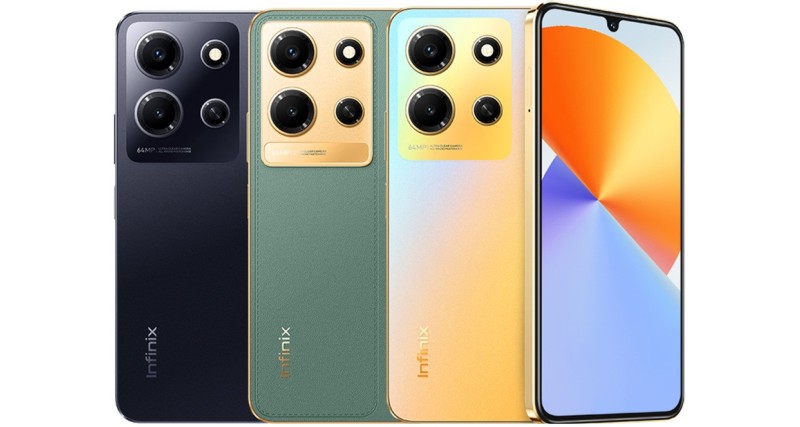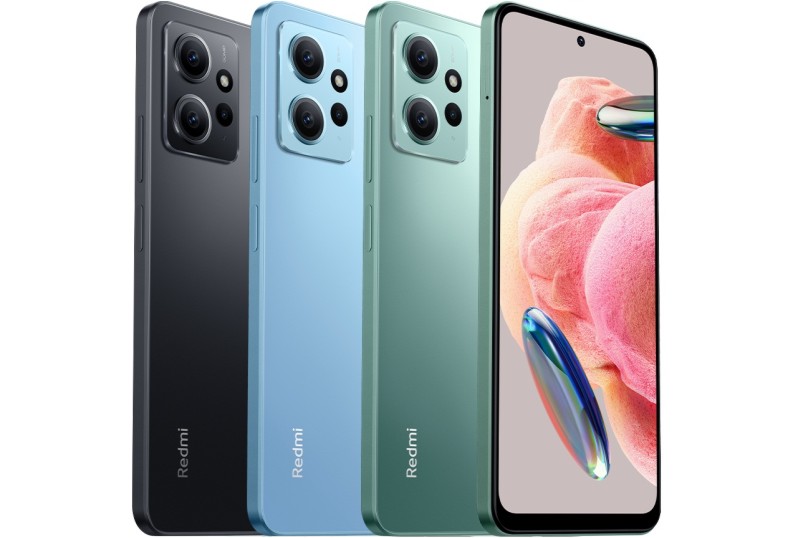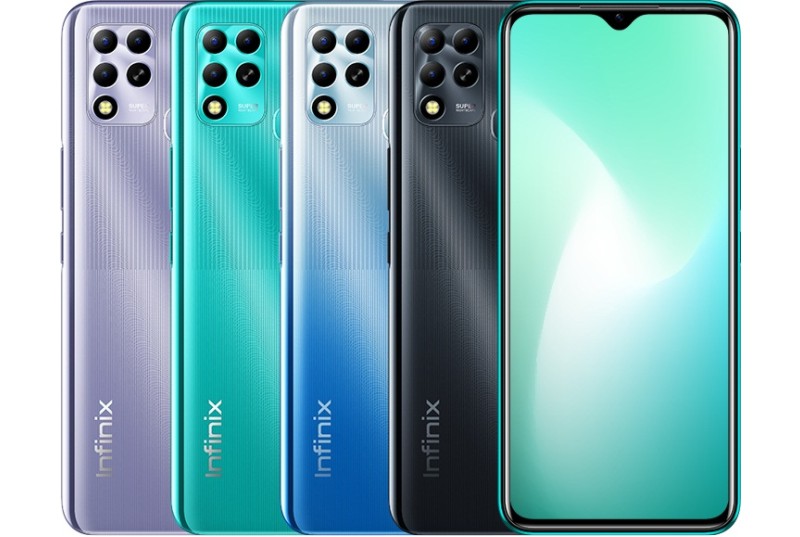Infinix Note 30 (X6716B) Price, Review And Specifications.
Infinix Note 30 (X6716B) Quick Specs:
6.66" Full-HD+ (2400×1080) AMOLED U-notched Display.
393ppi, 20:9 Aspect Ratio.
MediaTek Helio G85 Chipset.
Android 13, XOS 13.
Dual-lens (64MP+QVGA) Back Camera.
Single-lens (16MP) Front Camera.
8GB of RAM (Plus up to 8GB of Virtual RAM).
128GB/256GB Internal Storage.
Face Unlock.
Fingerprint reader (Side-Mounted).
USB Type-C Port:
4G (LTE) Network.
5000mAh Battery (33W Fast Charging).
Starting Price:
₦168,00, GH₵ 2,113, KSh 28,798.
At this price point, Infinix Note 30 (X6716B) is one of the very few affordable mid-range phones that managed to combine AMOLED display with higher RAM, higher storage space and higher megapixel rear camera. Yet the phone doesn't compromise on other regular features. For instance, Note 30 features fast charging rate, stereo speakers, up-to-date software and standard battery capacity.
But, for all these impressive features, there's a sacrifice; and it's the processor. In other words, Note 30 is equipped with a little less powerful CPU, compared to what few others are offering.
Nonetheless, the CPU is still a suitable one at this price point, especially when i considered the phone all encompassing features. Besides, Note 30 was able to maintain a consistence smooth performance.
Apart from the less powerful CPU, it should also be noted that the shots from the phone's higher megapixel rear camera are not the best looking in this class, though they are noticeably detailed and clear.
By the way, Infinix Note 30 is the standard (and most affordable) variant in the recently unveiled Infinix Note 30 series. Infinix Note 30 is followed by the better equipped Infinix Note 30 Pro (X678B). There's also Infinix Note 30 5G and Infinix Note 30 VIP.
Compared to the standard Note 30, the better equipped Note 30 Pro is fitted with a more powerful CPU and it also features a more impressive camera. The phone also support Wireless charging; which is rare at this price point. The Pro model is also IP53 certified, i.e., it's dust and splash resistant certified. Wired charging speed of the Pro model is also much higher.
NOTE: Although, like the Note 30 Pro, Infinix Note 30 also features Wireless charging, but the implementation is different. Because unlike the Note 30 Pro that supports standard Wireless charging, the regular Note 30 comes with a Wireless Charging Casing. You have to put the phone inside the Wireless Charging Casing and then place it on top of the Wireless Charging Pad; which also included inside the box of the Note 30 alongside the Wireless Charging Casing.
The Casing, which looks like a regular rubber casing, also has a USB Type-C port, just in case you want to charge your phone with a regular charger without removing the wireless casing.
By the way, the Wireless charging speed of the Note 30 is 15W. Besides, i think it's only inside the box of the 8GB/256GB variant of the Note 30 that these wireless charging features can be found, they're not inside the 8GB/128GB variant. Still, everything depends on your region or location.
It should also be noted that there are two variants of the Infinix Note 30 4G. The first one is the Infinix Note 30 (X6833B) while the second one is the Infinix Note 30 X6716B; which is the focus of our review. Though, both of the variants have the same camera setup, same RAM, same storage space and same battery capacity, but Infinix Note 30 X6833B is equipped with a much powerful CPU and it also features a faster quick charging. However, compared to the X6716B's AMOLED display, X6833B features IPS-LCD display. Still, the IPS-LCD display of the phone is slightly bigger and it also support high refresh rate (unlike the AMOLED display of the X6716B that features regular refresh rate). The front of the Note 30 X6833B also look prettier because it has a hole-punch camera, compared to the notched display of the Note 30 X6716B.
By the way, the variant you get also depends on your region or location.
Meanwhile, talking about its design, Infinix Note 30 features a premium sleek looks like most of the recent affordable mid-range phones. But, basically, the phone looks like the late last year's Infinix Note 12 G88 (x663). In other words, Note 30 has the same flat edges, flat back cover and an identical U-notched display as the Note 12 G88. It also maintain the earlier phone's form factor and screen size. However, the latest phone can still be identified by its flat and glossy rectangular camera space. Infinix Note 30 also appear to have four rear cameras (one at each corner of the glossy rectangular space). But in practical, the phone only has two rear cameras. The third spot is an LED Flash, while the fourth one is just for decoration.
The dual rear camera of the Note 30 is made up of a 50-megapixel main sensor and an AI or QVGA sensor. On the front of the phone is a 16-megapixel camera. Photos from the main rear camera are clear and have good contrast. The level of details is remarkable. Colours are also bright and saturated.
Selfies from the front-facing camera of the Note 30 are also clear and have decent level of details. And like the shots from the rear camera, selfies also have bright colours, even the colours are more solid.
Although photos from the front and rear cameras of the Infinix Note 30 look really nice, still there are few others at this price point that were able to deliver slightly better looking photos.
The U-notched display of the Note 30 also has the same screen properties as that of the earlier Note 12 G88. In other words, Infinix Note 30 has a 6.66-inch screen size and features an AMOLED panel. The screen also features the same 1080p resolution. And as expected of an AMOLED panel, the screen of the Note 30 looks more vivid and has richer colours than your average IPS-LCD display. It is also more brighter. But not the brightest around.
But, while most of the phones in this segment, even the less expensive ones with IPS-LCD panels, support high screen refresh rate, the AMOLED display of the Note 30 comes with standard refresh rate, just like the one on the Note 12 G88.
Infinix Note 30 is pre-installed with the recent Android 13 OS. And it also features 8GB of RAM and has two inbuilt storage options of 128GB and 256GB. Though as i said earlier, the CPU that powered this phone, which is Helio G85, is not that powerful, yet it is a good one at this price point.
Nonetheless, and by virtue of its higher RAM, Infinix Note 30 was able to deliver a consistent smooth performance. Even when it comes to demanding tasks like heavy internet browsing and quick multi-tasking, Note 30 maintain a steady lag-free performance. The phone's performance can still be boosted through MemFusion (or RAM Virtualization). Which enables you to create and add Virtual RAM (of up to 8GB) to the phone's Main RAM.
Though the rest of the Infinix Note 30 features are similar to those of others at this price point, yet, apart from the wireless charging features, there are two other features that are worth mentioning. Firstly, despite having the usual 5,000mAh battery capacity, the phone features a remarkable 33W fast charging. The phone also come with a pair of JBL-powered speaker. Though the stereo speakers are not the loudest in this class, but the audio quality is pleasant.
Price And Design Colours:
Currently, the starting price of the Infinix Note 30 Infinix is about 168,000 Naira. And it's available in design colour options of Obsidian black, Variable Gold, and Impression Green.
Other Contenders:
Tecno Camon 20 (ck6) shares almost everything with the Infinix Note 30. The Tecno phone features the same design, form factor and the same 60hz AMOLED display. Although, instead of notch, the screen of the Camon 20 has a camera cut-out. Still, the Tecno phone is fitted with the same amount of RAM, same processor, same storage space and same battery capacity. Camon 20 also has the same rear camera set-up as the Note 30, even photos from both phones look almost the same.
However, the front-facing camera of the Tecno phone has an higher megapixel sensor. Also compared to the Infinix phone side mounted fingerprint reader, Camon 20 features On-screen fingerprint reader. And despite having the same attributes as that of the Note 30, the display of the Camon 20 also seems to be slightly richer in colours.
Xiaomi Redmi Note 12 4G is another alternative. Though the Redmi phone is fitted with a slightly lower RAM than the Note 30, but it's equipped with a more powerful CPU. And despite that the Redmi phone is also fitted with a slightly lower megapixel rear sensor, the shots from the phone look more natural.
Furthermore, and despite that the more expensive Samsung Galaxy A24 is fitted with lower RAM like the Redmi Note 12, the phone is equipped with a much more powerful CPU than both of the Redmi and Infinix phones. And photos from the Samsung phone also more true-to-life than those of the Redmi phone, not to talk of the ones from Infinix Note 30.
But, talking about design, both Infinix Note 30 and Redmi Note 12 look more attractive, and they are of bigger size than the Samsung phone.
Infinix Note 30 Design:
Though, as a result of its flat edges and flat back cover, Note 30 shares design with most of the competitions, yet, due to few cosmetics enhancements, it looks and feels more premium than many of them. Firstly, Infinix Note 30 is a little flatter than most of its contenders because it has a lesser thickness of 8.12mm. However, in spite of its slimmer frame, the phone still weigh about 198g; which means it's a little on the heavy side. Though it has a good build quality.
Furthermore, and despite that the slimmer frame of the phone is made of plastic, it is coated with a metallic glossy material. And like the frame, the flat square-shape camera area (which houses the dual camera and quad LED-Flash) of the phone also has a glossy finish. And in contrast to the two glossy parts, the back cover sports a nice-looking semi-glossy or matte finish.
As i mentioned before, Infinix Note 30 is equipped with a pair of JBL-powered speakers. Although some of the competitions also offer stereo speakers, while many them have their second speakers embedded above the selfies cameras, the second speaker of the Note 30 is placed on the top flat edge. And the JBL brand is imprinted next to the speaker.
The arrangements of ports (and buttons), and their positions, remain as those of other phones in this segment. In other words, you have the volume keys and power button (which also doubles as a fingerprint reader) on the left edge of the Note 30, while its 4G dual nano-SIM+microSD card slot is located on the left edge. On the bottom edge of the phone is the first speaker, USB Type-C port, 3.5mm audio jack and an impressively clear microphone.
Bright And Detail Photos:
In default, the 64-megapixel main rear camera of the Note 30 shoot photos in 12-megapixel mode. Still photos are clear, sharp, and detailed. But if you desire a more remarkably detailed photos, you need to manually switch to 64-megapixel mode in the Camera Setting. And as i mentioned before, the photos have nice colour representation. Colours are bright and saturated. Dynamic range is also decent.
The selfies from the phone's 16-megapixel front camera are also clear, sharp and moderately detailed. And like the shots from the rear camera, selfies also appear vibrant and have slightly saturated colours; the colours even look more solid. Skin tone also look nice.
The Night Mode shots (from both the rear and front cameras) are also clear and bright. They are not over-blown and colours also look decent. They also have low photo noise.
Generally, photos from the Note 30 look quite good. Although, colours are a little saturated, and sometimes, especially when it comes to portrait shots, the camera struggles a bit with edge detection or subject separation. But as i said, and generally speaking, photos look good.
By the way, both the front and rear cameras of the Infinix Note 30 can shoot videos up to 2K at 30fps (frame per second). And there's no Image Stabilization.
A Nice Looking AMOLED Display:
The U-notched display of the Infinix Note 30 is technically the same as that of the previous Note 12 G88. Apart from the fact that it's also an AMOLED panel, its 6.66-inch screen size is approximately the same as the 6.7-inch of the Note 12. The Full-HD+ (or 1080p) resolution of the latest screen is also made up of the same 2400-by-1080 pixels. As a result, the screen of Note 30 is as clear, or as sharp, as that of the previous Note 12.
Other picture qualities of the Note 30 display are also similar to those of the Note 12 G88, and those of other affordable mid-range phones with AMOLED displays. For instance, the display of the Note 30 has deeper blacks, better contrast and richer colours, compared to an average IPS-LCD or PLS-LCD displays. The brightness level is also high. However, despite that the screen is bright enough for outdoor usage, the peak brightness is not impressive under direct sunlight bright enough.
Depite that the screen also inherit the con of the Note 12 G88 display; which is lack of high refresh rate, still, it has one unique feature that's similar to high refresh rate, and it's called Ultra-Touch. Ultra-Touch is made up of two parts; Swipe-Speed and Motion-Speed. And if you toggle On the two (or any) of them, you'll experience slightly smoother page swiping and scrolling.
Processing Power, Storage And Battery:
Out-of-the-box, Infinix Note 30 is running on the latest Infinix XOS Skin 13.0, on top of the Android 13 OS. And the phone was able to deliver a satisfactory performance.
Though, as i said earlier, the higher RAM contributes to the smooth performance of the Infinix Note 30, yet and basically, the Helio G85 CPU that's inside the phone was designed to handle quick multi-tasking and heavy internet browsing smoothly. Even, despite that it's a mid-range gaming chipset, the CPU handles many graphics demanding games easily. But, you need to drop the games' Frame Rates or Graphics Settings a little, to prevent occasional lagging.
And to further ensure a consistent smooth performance, Infinix Note 30 features MemFusion (or RAM Virtualization). The feature that is common among most of the recent affordable and mid-range phones. MemFusion enables you to convert up to 8GB out of the phone's inbuilt storage to virtual RAM. Thereby increasing the phone's default 8GB of RAM up to 16GB. And as usual, the latest phone's 128GB/256GB inbuilt storage can also be expanded, via microSD card, up to 1TB (One Terabyte).
And Finally, like the Infinix Note 12 G88 and other recent phones with the same 5,000mAh battery capacity and the same 33W fast charging. It'll take you about an hour and twenty minutes, and with the phone's 33W fast charger, to fully charge Note 30 battery when it drops to zero percent.
Infinix Note 30 (X6716B) Full Specs:
GENERAL
Maker: Infinix Mobility.
Name: Note 30 (x6716b).
Year Announced: April, 2023.
Dimensions: 164.5x76.7x8.18mm
Weight: 198g.
Colour: Variable Gold, Impression Green, & Obsidian Black.
DISPLAY
Screen Type: AMOLED-LCD capacitive Touchscreen.
Screen Type: AMOLED-LCD capacitive Touchscreen.
Size and Resolution: 6.66-inch, Full-HD+, 2400-by-1080 pixels, 60Hz Refresh Rate..
Aspect ratio & Pixel Densities: 20:9, 393PPI.
Protection N/a.
PORTS:
3.5mm Audio Jack: Yes.
USB Type-C Port: Yes.
MicroUSB port: No.
Lightning Connector: No.
Google Assistant Button: No.
PERFORMANCE
Chipset: MediaTek Helio G85 Octa-core Processor, 2.0GHz.
GPU: Mali-G52 MC2.
RAM: 8GB (plus up to 8GB of Virtual RAM).
Operating System: Android 13, XOS 13.0.
STORAGE
Internal Storage: 128GB/256GB.
Micro-SD card slot: Yes, up to 1TeraByte.
SIM AND NETWORK
SIM: Nano, Dual SIM slots.
Network: GSM, WCDMA, HSPA+, LTE.
CAMERA
Rear camera: Dual-lens; 64MP (f/1.69)+0.8MP, With Quad-Flash.
Front camera: Single-lens, 16MP (f/2.0), With Dual Front Flash.
VIDEO RECORDING:
Rear Cameras: 720p, 1080p, 2K @ 30 fps.
Front Camera: 720p, 1080p, 2K @ 30 fps.
CONNECTIVITY:
Wi-Fi, Bluetooth 5.0, HotSpots, USB-OTG, NFC.
BIOMETRIC, SENSORS & LOCATION:
Security: Face Unlock, Side-mounted Fingerprint Reader.
Sensors: Ambient light sensor, Proximity sensor, G-sensor, Accelerometer And
Barometer sensor
Others: GPS, Location (Geo, Glonass), Radio.
BATTERY
Battery Capacity: 5000mAh.
Qi Wireless-Charging: N/a.
Wireless Charging Casing: 15W
Wired Fast Charging: 33W.



.jpg)





